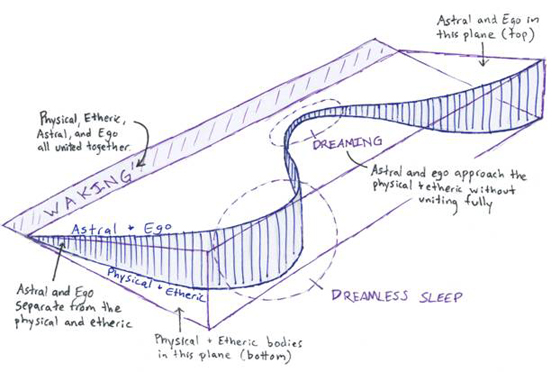
Image _MG_2109b (cc) by D N
If you are interested in the topics of alchemy, transformation of consciousness and dreams, I recommend checking out educational philosopher Seth Miller’s website at Spirit Alchemy. Miller has tons of scholarly articles that expand the work of Rudolph Steiner and the ancient esoteric system of alchemy as it applies to human development.
I am particularly drawn to his synthesis of modern dream science and Anthroposophy. No, I didn’t just spell “anthropology” wrong, although that’s what my wordpress editor thinks.”” “In its investigations of the spiritual world,” as Wikipedia suggests with a half raised eyebrow, “anthroposophy aims to attain the precision and clarity of natural science’s investigations of the physical world.”
Anthroposophy and Dreams
Miller weaves together our nightly journey through sleep and dreams with anthroposophic principles, using dream scientist William Dement as his scientific guide. In a nutshell, Miller sez,
The selective activation of the limbic system in the REM state corresponds with the increased activity of the astral body in the etheric body (which in turn works into the actual physical body). This activity is strong enough to activate the long-term memory centers and the emotional centers, but is not yet strong enough to fully activate the sensorial components of the brain. Only when the astral body and ego unite fully with the etheric and physical bodies, having passed through the morning gate of sleep, do the parts of the brain necessary for sense perception and thinking become activated.
Miller also makes great use of original sketches to visually display how Steiner’s theory of consciousness fits with modern neuroscience’s description of the stages of sleep.
 Image wakingdreaming by Seth Miller (2009), used with permission.
Image wakingdreaming by Seth Miller (2009), used with permission.
I”m always a sucker for an ancient psychology providing depth and understanding to accepted findings in Western science. Ancient systems of thought survive today because they are still applicable to our lives, and often these ancient metaphors are easier to grasp – as well as work with in our daily lives.
I’m not claiming to understand a lot about this *spiritual* matter, but from what you post here, the whole concept of Anthroposophy seems laughable. The discipline is defined as the study of the spiritual world using the same principles that the natural sciences use. Fair enough. Now, to do that, and to come up with a working definition for things like “astral body”, “etheric plane”, etc, we will need to prove that these concepts are applicable to a physical model of the functioning of the universe. Let’s to this quantitatively.
Oh, that’s right, these things belong to the unmeasurable, metaphyisical, etc! You can’t apply the scientific method.
And you can’t confuse mystics, poetry or art, with science.
Thanks Hugo for commenting. To restate why I think Anthroposophy has value: it is an ancient narrative based on empirical data – ie human first-hand experience. (tangent: In the Middle Ages, “empiricists” were considered charlatans, including midwives who recommended that health practitioners washed their hands.) Anthroposophy is valuable, in my mind anyways, because as a folk psychology it provides narrative and guidance. For example, people who understand the concept of “astral body” can go ahead and modify their conscious experience and have out-of-body experiences – that is a successful empirical narrative. So by looking at this folk psychology, and integrating it with the natural sciences, we have a more complete story of the phenomenon, inside and out.
And I recommend confusing mysticism and science…. many of our greatest scientists did, to our benefit!
Much of Anthroposophy has it’s background in Aristotle and Aquinas and both are still in high esteem by science, but one thing has science forgot, and that is Aristotle’s description of the psychological/spiritual of man, which is central to Anthroposophy.
I have made an article where I find the relation between the Jungian model and the Anthroposophic or Aristotelian model:
http://kimgraaemunch.wordpress.com/2009/01/17/what-are-the-feminine-and-masculine-sides-we-all-talk-about/
called “What are the feminine and masculine sides we all talk about?”
Regards, Kim
I’m puzzles as to why this site doesn’t mention Carl Jung, who I thought was the primary writer/investigator on this topic. So far Edinger’s book on the Psyche is the best I’ve found, but would like to find one with a clearer statement of the parallels between alchemical processes/imagery in dreams and the progression toward individuation.